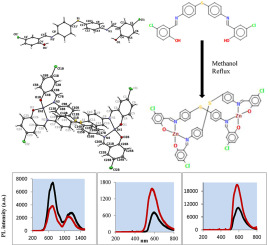Our official English website, www.x-mol.net, welcomes your
feedback! (Note: you will need to create a separate account there.)
Synthesis, structures, luminescence and thermal stability of Visible/NIR emitting binuclear azomethine-Zn(II) complexes
Journal of Luminescence ( IF 3.3 ) Pub Date : 2020-07-01 , DOI: 10.1016/j.jlumin.2020.117227 Aziza Sarwar , Siti Munirah Saharin , Hadariah Bahron , Yatimah Alias
Journal of Luminescence ( IF 3.3 ) Pub Date : 2020-07-01 , DOI: 10.1016/j.jlumin.2020.117227 Aziza Sarwar , Siti Munirah Saharin , Hadariah Bahron , Yatimah Alias

|
Abstract A series of binuclear azomethine-Zn(II) complexes was successfully synthesized from 4,4-diaminodiphenylsulphide derived Schiff bases, N,N-bis-(3,4-dihydroxybenzaldehyde)-4,4-diaminodiphenylsulphide (L1), N,N-bis-(5-nitrosalicylidene)-4,4-diaminodiphenylsulphide (L2), N,N-bis-(5-chlorosalicylidene)-4,4-diaminodiphenylsulphide (L3). The compounds were characterized through single crystal X-ray diffraction analysis, FT-IR, 1H NMR,13C NMR, energy dispersive X-ray diffraction (EDX), UV–Visible and photoluminescence spectroscopy. Single crystal X-ray diffraction analysis manifested that in the binuclear ZnL3 complex, two zinc ions bridge two Schiff bases with each metal centre adopting a distorted tetrahedral geometry, through coordination with two phenolate oxygen atoms and two azomethine nitrogen atoms. Each L3 ligand bonds two Zn(II) centres on different sides of the metals where the ligand flipped over to the opposite side around the S atom creating a twist. Photophysical properties of the synthesized compounds were explored in solid and solution states at room temperature. In solid state, the complexes revealed emissive properties in the visible and near infra-red (NIR) regions, with large Stoke's shift (Δλ) of 260–385 nm with respect to absorption, exhibiting emission in visible region (585 nm) both for ZnL2 and ZnL3 and dual emissive peaks in the NIR region (710 nm, 1199 nm) for ZnL1. Whereas, emissions in solution state (DMF) with lower intensity occurred at 465–545 nm. All complexes were subjected to thermogravimetric analysis with ZnL2 showing the highest thermal stability of up to 342 °C before undergoing decomposition. The good solid state emission properties illustrated that the complexes featured their potential as promising cost effective solid state photoactive materials.
中文翻译:

可见光/近红外发射双核偶氮甲碱-Zn(II)配合物的合成、结构、发光和热稳定性
摘要 以 4,4-二氨基二苯硫醚衍生的 Schiff 碱、N,N-双-(3,4-二羟基苯甲醛)-4,4-二氨基二苯硫醚 (L1)、N、 N-双-(5-亚硝基水杨烯)-4,4-二氨基二苯硫醚(L2)、N,N-双-(5-氯水杨烯)-4,4-二氨基二苯硫醚(L3)。通过单晶X射线衍射分析、FT-IR、1H NMR、13C NMR、能量色散X射线衍射(EDX)、紫外-可见光和光致发光光谱对化合物进行表征。单晶 X 射线衍射分析表明,在双核 ZnL3 配合物中,两个锌离子通过与两个酚盐氧原子和两个偶氮甲碱氮原子配位,桥接两个席夫碱,每个金属中心采用扭曲的四面体几何结构。每个 L3 配体结合金属不同侧的两个 Zn(II) 中心,其中配体翻转到 S 原子周围的相反侧,从而产生扭曲。在室温下以固体和溶液状态探索合成化合物的光物理性质。在固态下,复合物在可见光和近红外 (NIR) 区域显示出发射特性,相对于吸收而言,斯托克位移 (Δλ) 为 260–385 nm,在可见光区 (585 nm) 中均表现出发射ZnL2 和 ZnL3 以及 ZnL1 在 NIR 区域(710 nm、1199 nm)中的双发射峰。然而,在 465-545 nm 处发生强度较低的溶液状态 (DMF) 发射。所有配合物都经过热重分析,ZnL2 在分解之前显示出最高的热稳定性,高达 342°C。
更新日期:2020-07-01
中文翻译:

可见光/近红外发射双核偶氮甲碱-Zn(II)配合物的合成、结构、发光和热稳定性
摘要 以 4,4-二氨基二苯硫醚衍生的 Schiff 碱、N,N-双-(3,4-二羟基苯甲醛)-4,4-二氨基二苯硫醚 (L1)、N、 N-双-(5-亚硝基水杨烯)-4,4-二氨基二苯硫醚(L2)、N,N-双-(5-氯水杨烯)-4,4-二氨基二苯硫醚(L3)。通过单晶X射线衍射分析、FT-IR、1H NMR、13C NMR、能量色散X射线衍射(EDX)、紫外-可见光和光致发光光谱对化合物进行表征。单晶 X 射线衍射分析表明,在双核 ZnL3 配合物中,两个锌离子通过与两个酚盐氧原子和两个偶氮甲碱氮原子配位,桥接两个席夫碱,每个金属中心采用扭曲的四面体几何结构。每个 L3 配体结合金属不同侧的两个 Zn(II) 中心,其中配体翻转到 S 原子周围的相反侧,从而产生扭曲。在室温下以固体和溶液状态探索合成化合物的光物理性质。在固态下,复合物在可见光和近红外 (NIR) 区域显示出发射特性,相对于吸收而言,斯托克位移 (Δλ) 为 260–385 nm,在可见光区 (585 nm) 中均表现出发射ZnL2 和 ZnL3 以及 ZnL1 在 NIR 区域(710 nm、1199 nm)中的双发射峰。然而,在 465-545 nm 处发生强度较低的溶液状态 (DMF) 发射。所有配合物都经过热重分析,ZnL2 在分解之前显示出最高的热稳定性,高达 342°C。











































 京公网安备 11010802027423号
京公网安备 11010802027423号